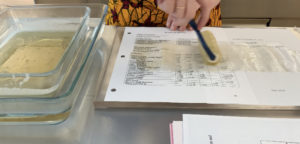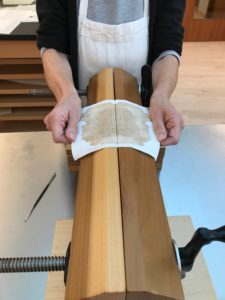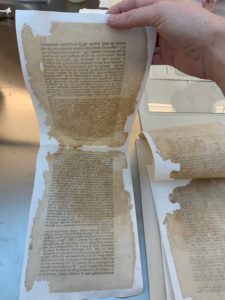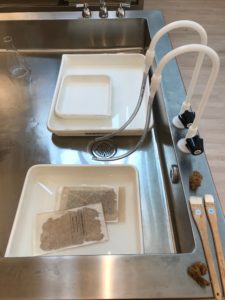During my internship this summer in the conservation lab at AAS, Chief Conservator Babette Gehnrich and I worked through several treatments one often sees in a paper conservation lab: mending, washing, pulp fills, and backing removals, among others. However, we also took a deep dive into the science and craft of a less frequently encountered treatment: paper splitting.
Paper splitting, as unlikely as it may seem, is exactly what it sounds like: one sheet of paper is separated along its thickness to form two sheets, which each have the same length and width as the original but are about half as thick. This may sound like an impossible magic trick, but with extensive knowledge of the properties of paper and many hours of careful practice, paper splitting is well within reach.

The reasons one might split paper depend on who’s doing the splitting. Dealers and collectors have split works of art on paper since at least the eighteenth century, most often to separate the front and back of a double-sided drawing. [1] This allows the front and back to be mounted or displayed simultaneously, each as a separate work. One could also sell each side separately as two unique works, generating larger profits, as was the case with the Great Mongol Shahnama, a celebrated fourteenth-century painted manuscript. [2] The prominent twentieth-century German restorer Max Schweidler even suggested that one might split a print to thin it for use as a lampshade! [3] As conservators, to the extent possible, we are tasked with preserving the material qualities of a work, guided by the American Institute for Conservation’s Code of Ethics and Guidelines for Practice. These applications of paper splitting, which result in a significant change to the work of art with no apparent preservation benefits fall well outside of our ethical bounds.
However, paper splitting does have some limited applications in the conservation lab. Splitting was adapted as a preservation technique in East Germany in the twentieth century, particularly to stabilize very brittle newspapers. At that time it was difficult to acquire necessary conservation supplies, particularly Japanese papers and tissues, which conservators frequently use for stabilization treatments. Splitting treatments became a useful workaround for these supply issues, and the process then was mechanized for bulk treatments. [4]
Brittle papers have long posed a challenge to collection caretakers, and numerous methods have been developed to stabilize them, each with varying degrees of success. Some of these methods, like plastic lamination, have (thankfully!) fallen out of fashion, but the problem of brittle papers remains. When faced with papers in this condition, conservators have limited options, as it is not possible to reverse the chemical processes that give rise to brittle paper once they’ve occurred. We might add support by lining one side with a lightweight, Japanese tissue, but this will obscure that side of the sheet, which is especially undesirable for papers with media on both sides. We might also simply place the paper into a chemically inert plastic sleeve, but this may not offer enough support for extremely damaged papers.
Splitting such a damaged paper might seem counterintuitive, but it gives conservators another option for treatment. Once the sheet is split, a conservator can insert and adhere a strong, high-quality tissue between the front and back sides of the original sheet. The two sides can then be rejoined, creating a kind of paper sandwich: the original front and back are the bread, and the new tissue is the filling. This tissue acts as a stabilizing core, offering support to the original paper without obscuring the front or back surfaces with a lining or lamination.
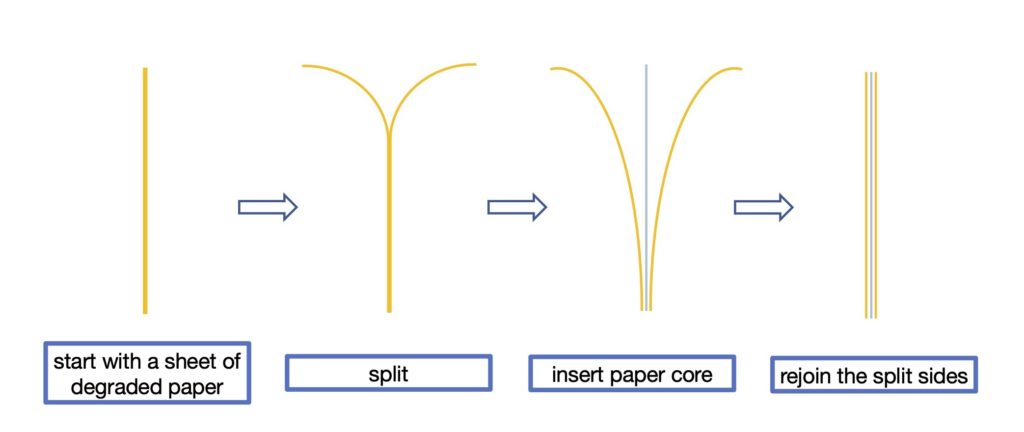
Here at the American Antiquarian Society, we had a perfect candidate in the lab for this technique: an early nineteenth-century pamphlet that appeared to have suffered extreme mold and water damage. The pamphlet arrived in the lab as a series of loose leaves, and the paper itself had lost all its internal strength, rendering it vulnerable to both surface abrasion and tears or fractures. Its condition made it nearly impossible to handle without causing further damage, even from within a protective plastic sleeve. The pages were also printed on both sides, and so we were hesitant to line them, as even very thin lining tissues would obscure the text and surface. Given these factors, the insertion of a paper core via splitting was an attractive solution.

Paper splitting is a dramatic act, and it can be rather destructive if attempted by an untrained practitioner. Sheets might split unevenly or not at all, leaving irreparable holes, tears, and skinning of the paper surface. To predict how this pamphlet would respond to a splitting treatment, we conducted a series of tests and mock-ups that simulated the conditions we planned to use. Conservators often conduct these types of tests before attempting complex treatments. After all, though our work is always designed to be re-treatable, each intervention by a conservator will inevitably leave a lasting trace in the life of an artifact. It is crucial to take that responsibility seriously!
Practitioners of paper splitting have followed the same general procedure for several centuries. In general, it works something like this:
- A strong facing paper is applied to the front and the back of the sheet of paper to be split using a strong, thick adhesive (in this case, gelatin).
- The whole package is pressed until nearly dry (usually overnight).
- The package is nicked at an upper corner and carefully pulled apart at that corner, initiating the splitting.
- The two sides are pulled apart from each other at 90-degree angle from the original sheet (forming a “T” shape) until the entire sheet has been split. The splitting is possible because the bonds between the paper and the thick gelatin used in step 1 are stronger than the internal bonds in the paper itself.
- At this point, a conservator will insert the supportive tissue core between the two split sides using methyl cellulose as an adhesive, rejoin them, and press the package again.
- The facing paper and gelatin are washed off the front and back in a hot water bath, revealing the front and back paper surfaces once more! The core remains in place during this step because methyl cellulose is less soluble in hot water.

Washing facing papers and adhesive off of the split paper and core
Once we were able to produce even, consistent, and reproducible results in our splitting tests, we were finally able to transfer this treatment method to the pamphlet in the AAS collection. Clearly, there are many variables in this process that one might manipulate: the type of papers used as the facing and the core, the amount of pressing time, the concentration of the adhesive solutions, and the moisture content of the papers are just a few one might consider. While we modified several of these variables during our initial tests to determine an optimal treatment method, it was important to keep them as consistent as possible during the actual treatment to minimize risk.
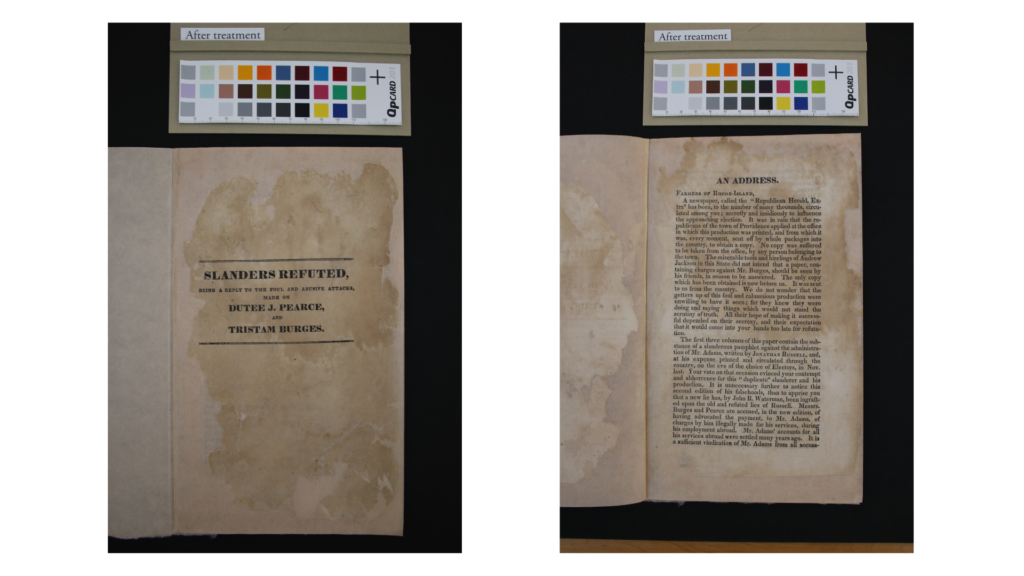
In the end, these careful preparations and consistent working methods resulted in a very successful treatment: all ten pages of the pamphlet split evenly and were rejoined with thin, strong paper cores. Once all the sheets were treated, Babette sewed them together into a pamphlet as was originally intended for this text. The paper regained significant flexibility and can now withstand some gentle, occasional handling, all without obscuring the front or back with linings or lamination. We considered this treatment a win-win for both the conservators and the object: we in the lab gained a new skill and an appreciation for the historic art of paper splitting, and the pamphlet can now leave the lab and serve the lively community of researchers at AAS!

[1] For more on this, see the video produced by the Morgan Library on the eighteenth-century collector Pierre-Jean Mariette and his potential paper splitting method: https://www.themorgan.org/videos/pierre-jean-mariette-and-splitting-drawings
[2] Sheila Blair, “Making and Mutilating Manuscripts of the Shahnama,” in Smarthistory, July 27, 2020, accessed October 6, 2021, https://smarthistory.org/making-mutilating-shahnama/.
[3] Max Schweidler and Roy L. Perkinson. 2006. The restoration of engravings, drawings, books, and other works on paper. Los Angeles: Getty Conservation Institute, 105.
[4] Wächter, W., J. Liers, and E. Becker. “Paper Splitting at the German Library in Leipzig — Development from Craftmanship to Full Mechanisation.” Restaurator 17, no. 1 (1996). https://doi.org/10.1515/rest.1996.17.1.32.
 Emma Hartman was a Conservation Intern at AAS in 2021. She is currently the Antoinette King Fellow in Paper Conservation at the New York University Institute of Fine Arts, where she is in her second year of the MA/MS program in art history and art conservation. She received her B.A. in art history and chemistry from Amherst College in 2017 and was a Fulbright-Nehru Student Research Fellow at the Indira Gandhi National Centre for the Arts in New Delhi, India from 2017-2018. Prior to graduate school, she worked as a conservation technician at the New York Public Library.
Emma Hartman was a Conservation Intern at AAS in 2021. She is currently the Antoinette King Fellow in Paper Conservation at the New York University Institute of Fine Arts, where she is in her second year of the MA/MS program in art history and art conservation. She received her B.A. in art history and chemistry from Amherst College in 2017 and was a Fulbright-Nehru Student Research Fellow at the Indira Gandhi National Centre for the Arts in New Delhi, India from 2017-2018. Prior to graduate school, she worked as a conservation technician at the New York Public Library.

